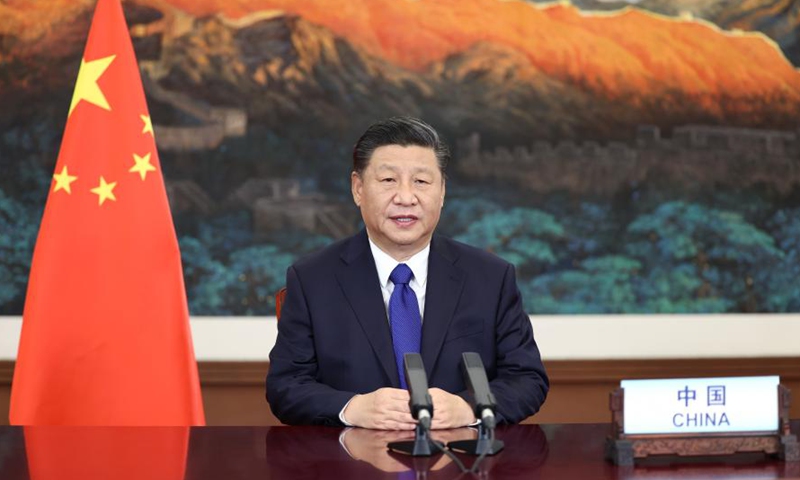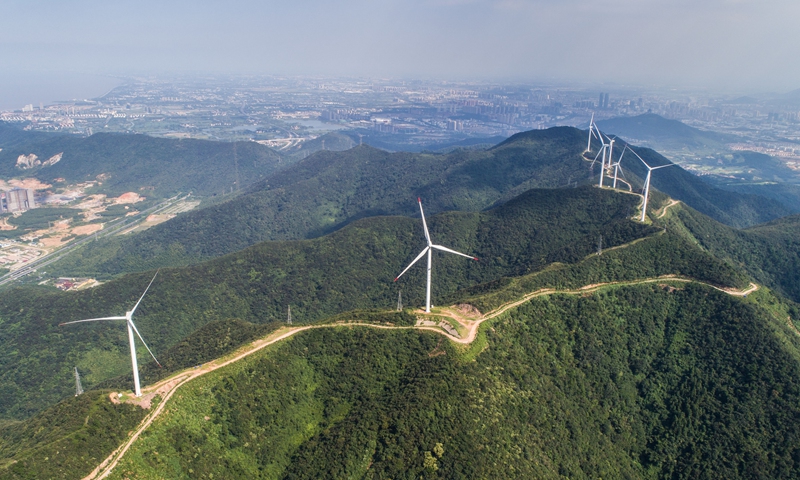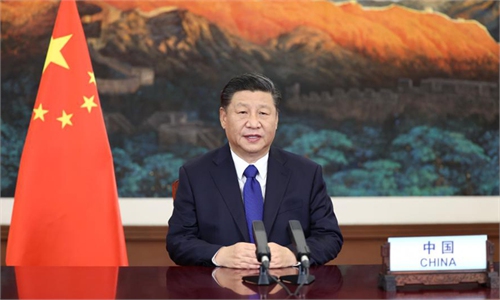Xi unveils tougher targets
to reduce CO2 emissions
As Beijing ramps up commitments, China can be a ‘pathfinder’ for the world in limiting global warming

Chinese President Xi Jinping addresses the Climate Ambition Summit via video link on Dec. 12, 2020. Photo:Xinhua
Chinese President Xi Jinping unveiled the country’s ambitious goals to fight climate change on Saturday night, pledging the country will greatly reduce carbon dioxide emissions and increase the share of non-fossil fuels and forest stock in the next decade, which is seen as ramping up the efforts to turn the pledge into concrete action.
The measures are expected to become the greatest boon for the global fight against climate change, which will consolidate the country’s leadership in tackling global warming around the world, as UN Secretary-General Antonio Guterres urged the world to take immediate action, paving the way for possible resumption of dialogue channels between China and the US amid escalating geopolitical tensions, analysts said.
At the virtual Climate Ambition Summit on Saturday, co-hosted by the UN, UK and France, Xi said that China has made important contributions to the adoption of the Paris Agreement on climate change and has made active efforts in implementing it. The country aims to peak carbon emissions before 2030 and achieve carbon neutrality before 2060.
Xi announced further commitments for 2030, including lowering carbon dioxide emissions per unit of GDP by over 65 percent from the 2005 level, increasing the share of non-fossil fuels in primary energy consumption to around 25 percent, increasing the forest stock volume by 6 billion cubic meters from the 2005 level, and bringing its total installed capacity of wind and solar power to over 1.2 billion kilowatts.
Xi’s address further clarified China’s timetable and roadmap to reach peak carbon emissions and achieve carbon neutrality, Xie Zhenhua, Chinese’s top climate advisor, was quoted as saying by China Central Television (CCTV) on Sunday. “It also responds to the international community’s hope of understanding how China’s timetable and roadmap for achieving carbon neutrality are laid out.”
“After proposing the goal to achieve peak carbon emissions and carbon neutrality, China intensified its own contribution to reducing carbon emissions, signaling that China is turning its climate change ambition into concrete action,” said Li Yan, chief representative of the non-governmental environmental organization Greenpeace, in a statement sent to the Global Times.
Xi pledged in September that China will adopt more vigorous policies and measures so the country will achieve peak carbon dioxide emissions before 2030 and achieve carbon neutrality before 2060.
During the summit, Guterres called on all countries to declare a climate emergency and increase their ambitions to cut greenhouse gas emissions, otherwise, the planet faces a catastrophic temperature increase of over 3 C by the end of the century, according to media reports.
Xi’s remarks have clarified that China’s role in the world’s mission to tackle climate change is one of a “pathfinder,” Ma Jun, director of the Beijing-based Institute of Public and Environmental Affairs, told the Global Times on Sunday.

Aerial photo taken on Aug. 23, 2018 shows the Bianshan wind farm in Changxing County, east China's Zhejiang Province. (Xinhua/Xu Yu)
China’s goals have not come from external pressure, but from its own will, Ma noted. “It is anticipated by the world and [China] has been followed by other countries such as Japan and South Korea in announcing their goals to become carbon neutral.”
The specific goals to reduce emissions, which also set new objectives for the wind and solar power industries, also send a positive signal from the central government that it will accelerate low carbon development, which urges energy-intensive industries to transform.
Compared to the 2015 version of China’s intended nationally determined contributions to reduce emissions, the 2020 version shows China has stepped up its efforts. For example, in the 2015 version, the country outlined aims to lower carbon emissions per unit of GDP by about 60 to 65 percent from the 2005 level by 2030, while the latest version aims to reduce it by 65 percent.
Compared to the 2015 goal of increasing the share of non-fossil fuels in primary energy consumption to 20 percent, the new pledge aims to increase the share to around 25 percent.
The new goals will bring challenges and pressures for China’s economic development, as the country is under a large-scale industrialization and urbanization drive as well as the economic recovery in the wake of the COVID-19 pandemic, Ma said.
But the challenges will mean new opportunities, Ma noted. “China’s self-imposed pressure could accelerate the transition to green low-carbon development and lift the efficiency of economic development,” he said. For example, because of the renewable energy technology that China has developed, the cost of solar energy has fallen to a similar level of traditional energies, and the cost of wind power is also reducing in China.
Xie noted that not only the energy sector needs to be transformed, but also the modes of production, lifestyle and consumption. He said that after the announcement of the new measures, China will play a leading role, and the measures will serve as a guide to promote accelerated innovation and transition in the country. “It is consistent with China’s strategy of sustainable, high-quality and green development,” Xie said.
US-China dialogue
US president-elect Joe Biden pledged Saturday to rejoin the Paris climate accord on the first day of his presidency, after the outgoing administration of President Donald Trump pulled Washington out of the agreement four years ago, the AP reported.
China took the initiative to deliver an olive branch on climate issues which will also become the most promising area for China and the US – the world's two largest emitters – to resume dialogue, following months of escalating confrontation in geopolitics, trade and high-tech, according to analysts.
“It will also lay a foundation for cooperation between the two countries, help bring divergences under control and prevent the bilateral relationship from continuing to deteriorate,” Lin Boqiang, director of the China Center for Energy Economics Research at Xiamen University, told the Global Times on Sunday.
If the confrontation between China and the West, led by the US, on the ideological front continues after Biden takes office, China will need such a platform of cooperation with others in order to avoid being “isolated,” Lin said.
As Biden commits to rejoin the Paris Agreement and take action on climate change, some foreign scholars agreed there will be opportunities to work with China.
“As for COVID-19 and climate change, there is plenty of room for the US and China to find areas of cooperation and no real reason to be in conflict,” Douglas Paal, Distinguished Fellow at the Carnegie Endowment for International Peace of the US, told the Global Times in a recent interview.
While the Trump administration withdrew from the Paris Agreement and obstructed country-level communication with China on climate, there was still room for grassroots NGOs, companies and authorities at federal levels between China and the US on this matter, although this is still insufficient, analysts said.





